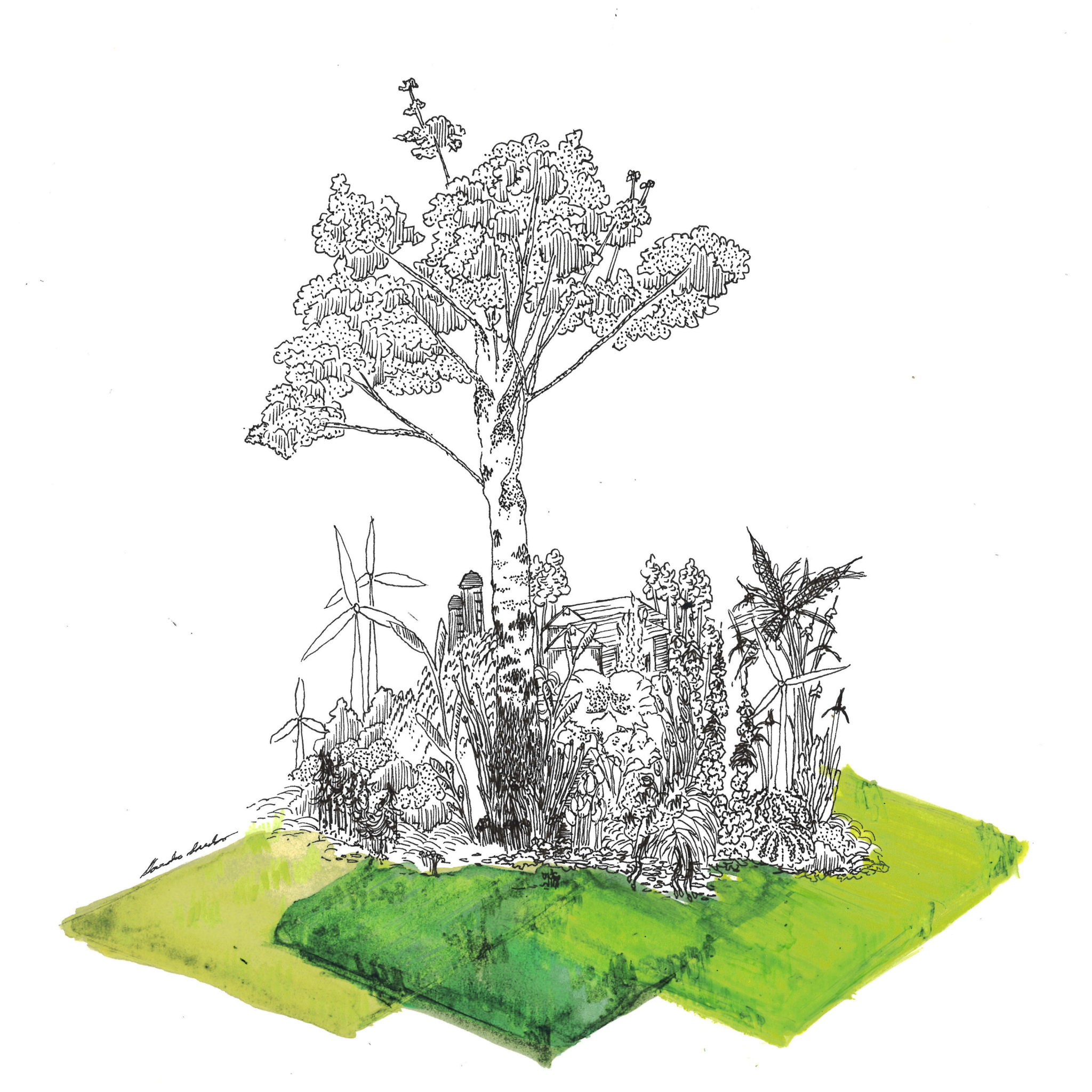By this spring, a factory roof in Pullman will be home to a farm that grows up to a million pounds of pesticide-free produce a year. As 9th Ward Alderman Anthony A. Beale says, “That amount of lettuce is unreal!” When it opens up on top of eco-friendly cleaning product company Method’s new manufacturing plant, Gotham Greens’ rooftop farm will be the largest of its kind in the world. Not only will it grow produce year-round, but, along with Method’s plant, the farm will also bring close to 150 new jobs to the community. The plans are an exciting development for an area that has historically had a higher unemployment rate than the city as a whole, but they also highlight a divide between Pullman proper and the surrounding area.
Gotham Greens designed and will operate the 75,000 square feet of greenhouses on the Method plant’s roof, growing leafy greens and culinary herbs (for comparison, the median size of Chicago’s 350-odd vegetative roofs is only 5,234 square feet). Viraj Puri, Gotham Greens’ co-founder and CEO, describes the collaboration: “Method…wanted to integrate food production into the plant,” he said. “They were seeking a greenhouse partner who had the experience and ability to execute the design, construction, and operations of a large scale rooftop greenhouse facility, which led them to Gotham Greens. The rest of the story developed organically.”
Although Gotham Greens’ other farms are in New York City, the opportunity to contribute to the revival of Pullman, as well as Chicago’s combination of strong local food culture and scarcity of fresh produce during the lengthy winters, made Chicago, Puri said, “a logical next step for us.”
Huge as the factory is, it’s dwarfed by the windswept fields of snow and browning weeds around it. It’s easy to tell that the roof’s greenery and the whir of the plant’s assembly lines will be a huge change for the Pullman site, which for nearly a decade housed only an abandoned steel processing facility. Yet these changes simultaneously recall the site’s past; this plot of land was also, in its heyday, home to part of the historic Pullman rail car plant. The Pullman neighborhood traces its beginnings back to 1880, when George M. Pullman bought a huge tract of land to create a model industrial town where employees of his rail car company would live and work.
According to David Doig, president of the nonprofit community development organization Chicago Neighborhood Initiatives (CNI), which as master developer of the Pullman Park development worked to help bring Method to Pullman, this historical background was one of the things that drew Method in (Method did not respond to requests for comment). “They really liked the idea of what they represented juxtaposed [with] what Pullman represented,” he explained. “So, much the way that Pullman was innovative in the nineteenth century, you have Method now as…the new green economy, representing the new innovations of the twenty-first century.”
Another factor was the company’s desire to participate in a larger community development strategy. Over the past five years, Doig says CNI has completed over $100 million in developments, including the Walmart that opened next to Method’s lot in 2013. Ultimately, CNI plans to add recreation and park space, mixed-income housing, and more big-box stores. In press releases, Method has touted its own contribution to the area’s revitalization, stating that the factory will create nearly a hundred manufacturing jobs in an area with relatively high rates of unemployment.
Method did not choose Pullman entirely of its own accord: CNI had been looking for potential industrial real estate buyers for Pullman Park, and together with Alderman Beale and community members, they undertook what Beale described as a “full-court press” to persuade Method that the area was the right choice for its plant. CNI put together a package that included about $8 million in tax increment financing (TIF) money from the city and did much of the infrastructure work on the site itself. Beale brought several Pullman community leaders to a meeting with the company; Method said their discussion with those leaders sold them on coming to Pullman.
The difference the factory and farm would make in the community is the center of Beale’s argument for the project. “Number one,” he told me, “I believe it’s going to have an impact on the quality of life that people lead, having a void of fresh produce that’s being filled.” Pullman has been called a food desert by both Pat Quinn and the research firm Mari Gallagher that helped popularize the term; the construction of Walmart a couple of years ago (despite some residents’ concerns about its labor practices) provided the neighborhood with its only major grocery store. Combining that with Gotham Greens’ farm could improve Pullman’s situation even further.
“Walmart is only about fifty feet away from Gotham Greens,” Beale pointed out, “so they’ll be able to grow, package, and deliver fresh produce right across the street.” Gotham Greens spokesperson Nicole Baum says that the company has not finalized a full list of retailers for the produce, but is in discussions with restaurants, farmers’ markets, and stores across the South Side and the greater Chicago area. Beale, meanwhile, is just as effusive about the project’s potential to put people to work: the farm alone is projected to create more than fifty jobs.
Area residents, however, are concerned about the type and availability of the jobs Gotham and Method claim they’ll provide. Kemba Chambers, who lives nearby, looked up the job postings on Method’s website after seeing the factory’s towering wind turbine, but was disappointed. “They seemed to only be looking for specialized engineers,” she said. “I don’t know if that’s really what the community needs.”
Though Method’s current postings do include multiple kinds of engineers, they also include opportunities such as “the mover and the maker: operation technician,” i.e. production line worker. There’s little middle ground between the two, however, and the whimsical naming of several of the positions (maintenance technicians are referred to as “MacGyvers”) is not likely to make things any clearer. And Chambers is not alone in raising questions: Chris Campagna, a member of local group Pullman Urban Gardeners, mentioned that he had heard from other locals that it was difficult to find a job through Method, although he expressed confidence that the company would clear up any confusion soon.

Still, community groups seem enthusiastic about the project on the whole. Though there are gripes about the details of the project’s implementation, it’s hard to find a downside to fresh lettuce. The Cooperation Operation, a nonprofit organization that grows free organic produce, expressed its support. “As far as the project goes, in a conceptual way I think it’s awesome,” co-founder Justin Booz says. “Personally, I think the more food that can be grown locally and sustainably, the better.” Having met with them, he thinks Gotham Greens is doing a good job of reaching out to the neighborhood, “They’ve been really forthcoming in offering support,” he said.
As for Pullman residents in general, Campagna gave the impression that most were thrilled. “I’ve not heard one negative comment at all, not one, about the rooftop farm from Method, which is unusual,” he chuckled. “I think what Method [and Gotham Greens] are doing is fantastic…and I’m sure many Pullmanites are behind what they’re doing.”
That may be true of Pullman residents, but what about those outside Pullman’s borders? The neighborhood tapers as one moves south, squeezed between the Metra tracks and the Bishop Ford Freeway; the farm’s location is near the vertex, so it is only blocks from Roseland, South Deering, and even suburban Riverdale. Speaking to a dozen individuals from those neighborhoods, outside the Pullman Walmart—yards from Method’s factory, in the shadow of the prominently branded wind turbine—few had any idea what the factory was, and only one had heard of Gotham Greens’ farm.
Beale, whose ward extends ten or twenty blocks beyond Pullman in several directions, has been trying to keep locals informed: he tells me that he has mentioned Method in his newsletters, that he had them present information at his town hall meeting when they started hiring and even made a phone blast about it, and that he will employ similar efforts when Gotham Greens begins their hiring. “We’re doing everything we can to let the community know that Method is here and Gotham Greens is here,” he said.
Is everything Beale can do not enough, and should Method and Gotham Greens themselves be doing more? Either way, the contrast between the Pullman residents’ pep and the blank stares of members of other neighborhoods raises questions about the breadth of the project’s impact. Pullman has slightly higher per capita income than its neighbors, at $20,588 to Roseland’s $17,949 and South Deering’s $14,685, according to the Chicago Department of Public Health’s 2008–2012 estimates. By the numbers, there is not much else that sets the neighborhood apart from its surroundings, but the neighborhood’s history has conferred on it a certain degree of prestige. That has some concrete benefits: the Pullman Historic District was just designated a national monument, which is likely to bring more jobs and development to the area, and the organizing locals did over the years to preserve that history has given them a strong foundation for creating change in the community. It creates a narrative, too: the rhetoric about the opening of the plant and farm, consistently Pullman-centered, includes individuals such as Doig pointing to the neighborhood’s “strong workforce,” calling to mind a history of industry and industriousness.
Semaj Bailey lives near the Method factory but not in Pullman. “The rooftop farm would be a good idea if it’s shared,” she said, “but it doesn’t help if it only goes to Pullman…what do people do on this side of the [Metra] tracks?” As great of a story as that may make, the focus on Pullman—both in word and in deed—may run the risk of being exclusionary.
Correction February 24, 2015: An earlier version of this article stated that Gotham Greens’ farm would grow over sixty thousand heads of lettuce a week. That number was a loose estimate from a source outside the company; Gotham Greens cannot confirm an estimate of lettuce production.



How can I want to get involved?
I love the fact the concept of a greenhouse with sustainable produce and the fact that the Pullman (Chicago) location was selected as the first outside of the locations on the east coast.
I have applied for the HR Coordinator/Office Manager position which would allow me to become a part of a historic endeavor.